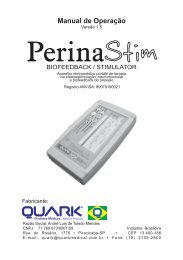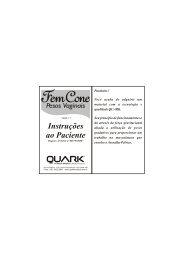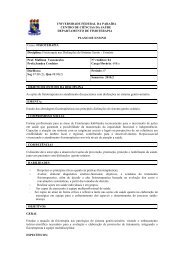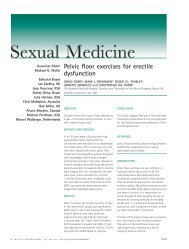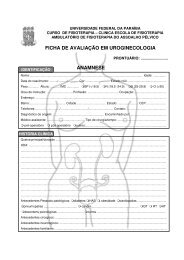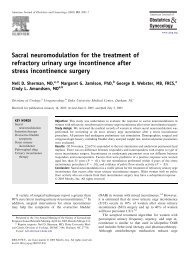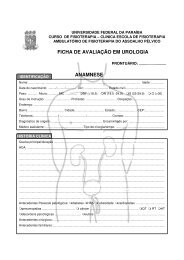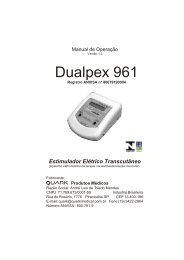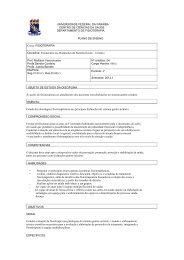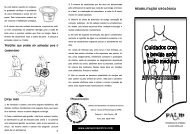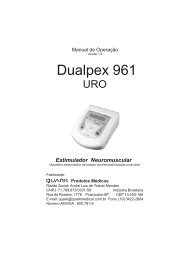vacuum constriction devices for erectile dysfunction
vacuum constriction devices for erectile dysfunction
vacuum constriction devices for erectile dysfunction
Create successful ePaper yourself
Turn your PDF publications into a flip-book with our unique Google optimized e-Paper software.
MATERIAL AND METHODS<br />
PATIENT EVALUATION<br />
Between 1990 and 1996, 146 patients were enrolled in our<br />
Osbon study. These patients all presented to our clinic with a<br />
complaint of <strong>erectile</strong> <strong>dysfunction</strong>. All patients completed a<br />
detailed sexual function questionnaire at their initial office<br />
visit. From this survey, the duration and severity of the <strong>erectile</strong><br />
<strong>dysfunction</strong> were determined.<br />
The <strong>erectile</strong> <strong>dysfunction</strong> of patients whose penis had atrophy<br />
with degenerative changes of the penile tissue and whose<br />
penis was completely limp or became full but without hardness<br />
was classified as complete. The <strong>erectile</strong> <strong>dysfunction</strong> of<br />
patients who achieved sufficient hardness <strong>for</strong> intromission but<br />
were unable to maintain their erection was classified as moderate.<br />
The <strong>erectile</strong> <strong>dysfunction</strong> of those patients who could<br />
penetrate and achieve orgasm was classified as mild.<br />
Each patient was seen and evaluated by one of us (J.F.E.),<br />
who took a detailed medical and sexual history. A complete<br />
physical examination was conducted, as were studies of serum<br />
testosterone and duplex Doppler ultrasound of the penile arteries<br />
combined with intracavernous administration of prostaglandin<br />
E 1. In this manner, all patients were diagnosed with<br />
vascular, cavernosal, neurogenic, or hormonal <strong>erectile</strong> <strong>dysfunction</strong>.<br />
Only patients with these organic diagnoses were included<br />
in the study.<br />
INSTRUCTION<br />
Patients with a diagnosis of organic <strong>erectile</strong> <strong>dysfunction</strong><br />
were presented, in a nonbiased manner, with choices of no<br />
treatment, VCD, injection, or implantation. All patients included<br />
in the study chose the VCD as the first line treatment.<br />
The Osbon VCD was the only device prescribed to limit variables<br />
and because tutoring by an Osbon representative was<br />
available. All patients received verbal instruction from an Osbon<br />
ErecAid representative on the use of the VCD, viewed a<br />
videotape, and received an individual demonstration. If the<br />
patient achieved a satisfactory erection with the sales representative<br />
in an office setting, the patient received a prescription<br />
<strong>for</strong> the Osbon ErecAid System. Patients were then followed<br />
up by one of us (J.F.E.) and obtained advice or<br />
alternative treatments as necessary.<br />
FOLLOW-UP<br />
In late 1996, patients received a follow-up questionnaire by<br />
mail. Those who did not respond or did not complete the<br />
questionnaire entirely were followed up by telephone. Patients<br />
who could not be reached were considered to have<br />
dropped out of the study.<br />
RESULTS<br />
Of the 146 patients originally enrolled in the<br />
study, 129 completed the patient questionnaire<br />
and were included the analysis. The mean time of<br />
follow-up was 37 months after receiving the Osbon<br />
prescription. All but 11 patients included in the<br />
study had filled their prescription more than 12<br />
months be<strong>for</strong>e completing the follow-up questionnaire.<br />
At the conclusion of the study, 84 patients<br />
(65%) were no longer using the device (inactive),<br />
and 45 patients (35%) were still using it (active).<br />
Patient age and diagnosis were comparable between<br />
the two groups. The mean age of active patients<br />
was 66 years (range 52 to 78), compared<br />
with 64 years (range 39 to 80) <strong>for</strong> inactive users.<br />
FIGURE 1. Months of use from time of purchase until<br />
discontinuing.<br />
Diagnoses were very similar between the two<br />
groups; the most common etiology was vascular,<br />
followed by cavernosal, neuronal, and hormonal.<br />
Nine of the patients (7%) had mild <strong>erectile</strong> <strong>dysfunction</strong>,<br />
54 (42%) had moderate <strong>erectile</strong> <strong>dysfunction</strong>,<br />
and 66 (51%) had complete <strong>erectile</strong> <strong>dysfunction</strong>,<br />
as defined above. All 9 patients with mild<br />
<strong>erectile</strong> <strong>dysfunction</strong> discontinued use of the VCD.<br />
Patients with complete <strong>erectile</strong> <strong>dysfunction</strong> also<br />
quit at higher rates (70% quit and 30% continued).<br />
Patients with moderate <strong>erectile</strong> <strong>dysfunction</strong> were<br />
the most likely to continue using the device (55%<br />
quit and 45% continued). Fisher’s exact test <strong>for</strong> use<br />
status as a function of severity indicated that the<br />
percentage of patients who stopped was significantly<br />
different across the severity levels (P <br />
0.01).<br />
Among inactive patients, the average number of<br />
months be<strong>for</strong>e quitting was 4 months (median 1,<br />
range 1 to 36) (Fig. 1). The three most common<br />
reasons <strong>for</strong> stopping use were as follows: 48% (n <br />
57) considered it ineffective, 20% (n 17) too<br />
painful, and 24% (n 20) too cumbersome (Table<br />
I). Additional reasons <strong>for</strong> drop out were as follows:<br />
5 considered the erection to be artificial, which led<br />
to a loss of desire, 2 reported loss of a partner, and<br />
6 reported that their ability to obtain a natural erection<br />
had been restored. Follow-up treatments <strong>for</strong><br />
the 84 patients who dropped out were as follows:<br />
31% (n 26) received intracavernosal therapy, 6%<br />
(n 5) received a prosthesis, and 63% (n 53)<br />
chose to receive no further treatment (Table I).<br />
COMMENT<br />
Previous studies of VCDs have had varying satisfaction<br />
rates. Some studies have shown high satisfaction<br />
rates, 3,6–9 but other studies have shown<br />
lower satisfaction rates. 1,10 Some researchers have<br />
892 UROLOGY 54 (5), 1999





